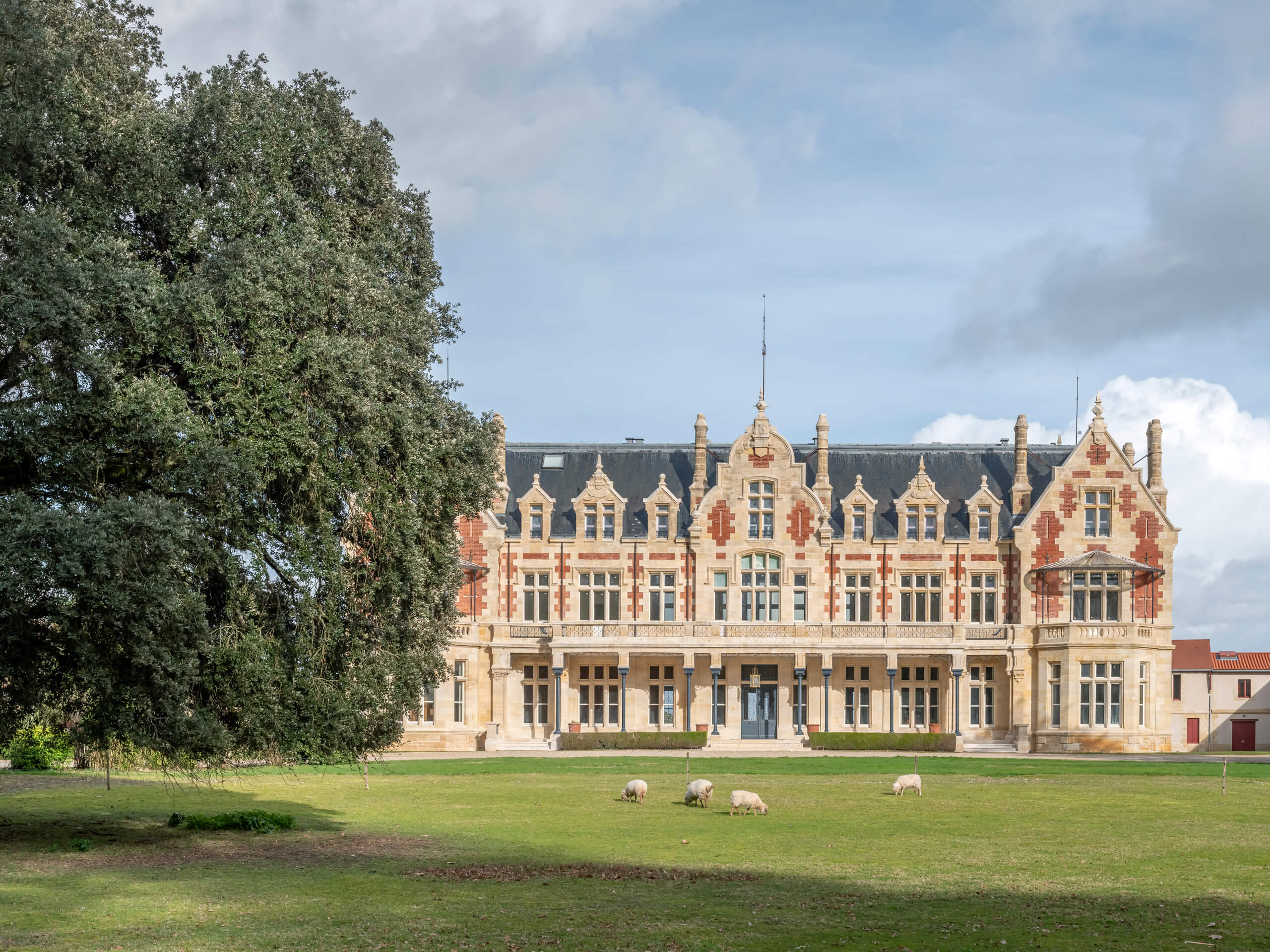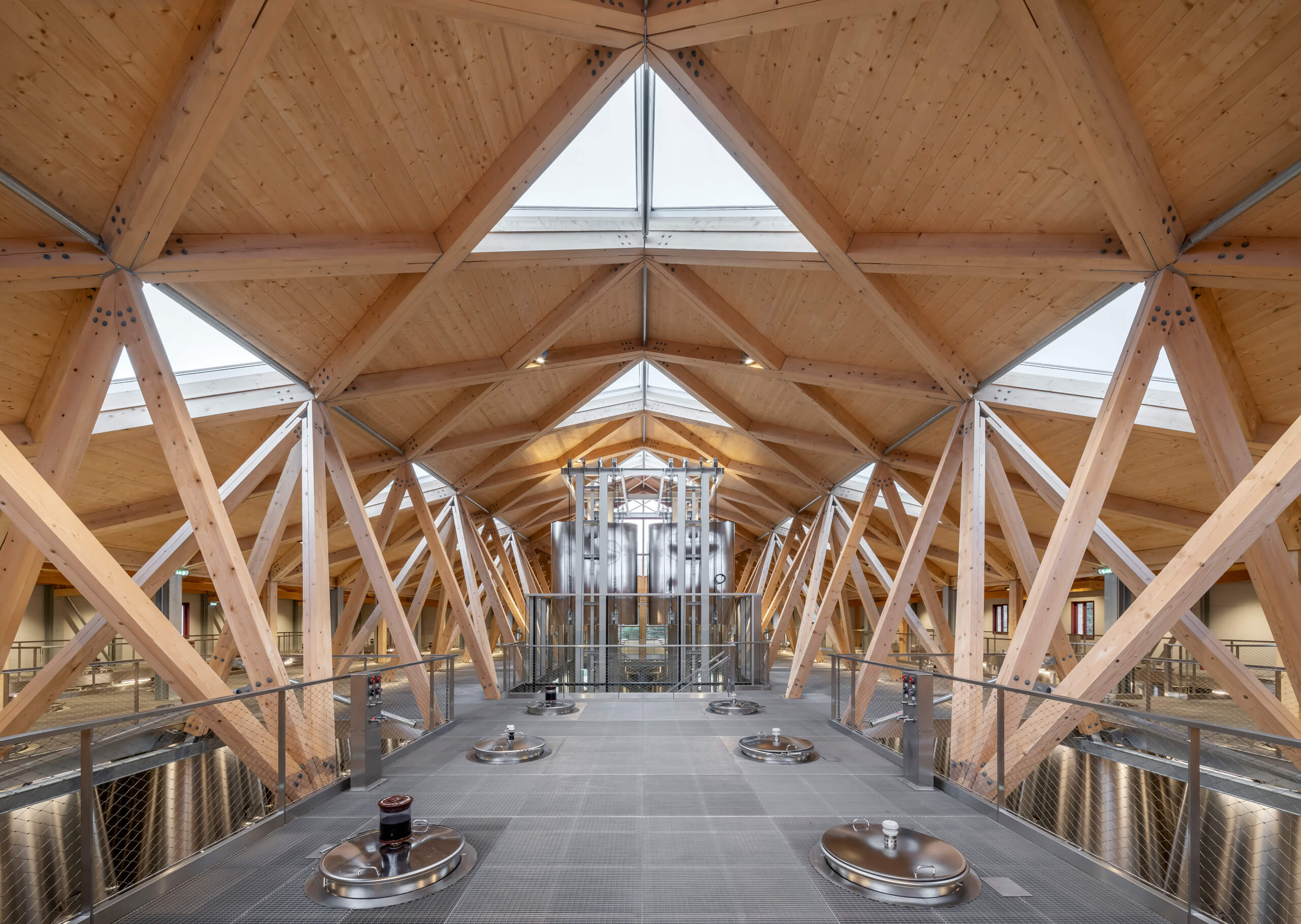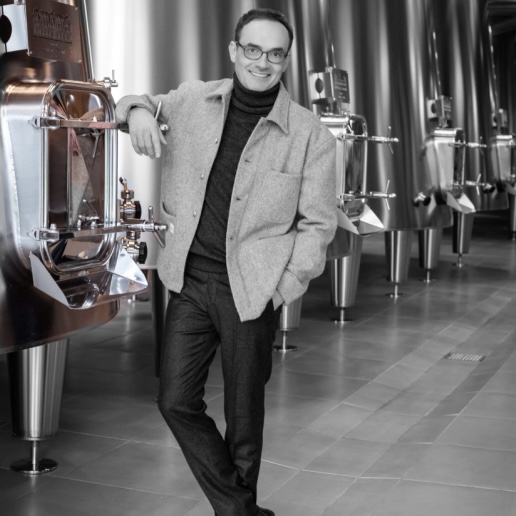Tristan Le Lous
Owner
Château Cantenac Brown
3ème Cru Classé
Margaux
In May 2022, when I met José Sanfin, manager of Château Cantenac Brown for over 34 years, we discussed the fact that this magnificent estate has been bought by the Le Lous family in 2019. It seems obvious to meet the new owners in order to understand the vineyard’s new destiny. A recent arrival in the Médoc, the Le Lous family are one of France’s largest entrepreneurial families in the pharmaceutical sector. Tristan Le Lous represents the family at the head of this prestigious château.
As soon as, they acquired the château, , the family decided to rebuild the winery to give it an ultra-modern building that meets both environmental and aesthetic requirements. During my visit to Cantenac Brown, I had the opportunity to ask Tristan Le Lous a few questions. First, he showed me the magnificent mud cellar, designed by architect Philippe Madec, superbly integrated into the landscape, allowing the eye to focus on the Tudor-style château, created more than 200 years ago by Scotsman John-Lewis Brown.

Presentation & Career
Gerda: Could you introduce yourself and tell us about your career before acquiring Château Cantenac Brown?
Tristan Le Lous: With my 2 brothers, I run a pharmaceutical group called Urgo. It’s a family company that’s been around for 140 years and is based in Burgundy. It was my grandfather who took over the company in the early 50s. My brothers and I have been at the helm for the last 5 years. I’m an agricultural engineer, which gives me the tools to talk about the wines with José Sanfins, the estate manager.
G: What were the main reasons for buying a wine estate in Bordeaux?
TLL: It was partly a dream, but it was also a diversification strategy for the group, because a project of this scale can’t just be a dream. It’s both the culmination of the passion that my two brothers and I share, and an entrepreneurial investment project. Both aspects motivate me enormously, which is why we embarked on this acquisition project in December 2019. We simultaneously set about building this new winery to promote the brand and acquiring new plots of land for Cantenac Brown.
Challenges
G: What are the main challenges you’ve faced since becoming owner?
TLL: I’ve been extremely fortunate that this property has been wonderfully looked after for so many years by José. He has been the emblematic figure of Cantenac Brown for a long time. He arrived in 1989 as a trainee and now has 30 exceptional vintages to his name. Thanks to him, Cantenac Brown has become a wine renowned for its structure and tension, with mellow tannins and a taut finish. José’s presence at my side to continue this adventure after the acquisition was an invaluable asset.
However, we have overcome a number of challenges since the takeover in 2019. We started building the winery in the middle of a pandemic, and despite this, it was completed in time for the 2023 harvest. The project was complex because of its innovative nature and the materials used, and had to be speeded up. To anticipate the particularities of the construction, we made a model of the mud wall in the garden to understand how the joinery would fit into it and to determine the dimensions needed for the roof. The finishing details were particularly complicated.
Completing this vast 6,000 m2 project, which was entirely eco-responsible, using raw and bio-sourced materials such as raw earth and wood, was the biggest challenge I had to face. Fortunately, I had José to continue managing the estate and producing the wine in the meantime.
G: You’re a great entrepreneur and you know that the Bordeaux wine market is currently going through a crisis. How is this crisis affecting a wine like Cantenac Brown?
TLL: My first primeur campaign took place in 2020, at the height of the crisis in Bordeaux due to the Covid-19 pandemic, a particularly complicated year. However, the following two years were exceptional. In 2022, we sold Cantenac Brown for the highest price in the Château’s history. This year, we’ve had to reduce our price, but I don’t think that reflects a lack of dynamism in the market. Nevertheless, we’re going through a difficult year.
This crisis is perhaps affecting me less than I expected, because I remain serene and convinced that the GCC market dynamism will return. It’s crucial to know how to manage these cycles. Despite my lack of perspective, my main motivation is to develop our messages and differentiate the Cantenac Brown brand.
My aim is for Cantenac Brown to be recognised for the quality of its wines, and not just as an 1855 3rd Growth in Margaux.
I’m not sure to what extent the current crisis in Bordeaux is linked to the cost of carrying wine stocks, which is higher because of the rise in interest rates. My impression is that this industry is sensitive to rising rates. I hope that the next fall in interest rates will revive the market, especially as the distribution chain will be de-stocking in the meantime. So I expect the market to pick up again if a lot of the current problems, which are making the 2023 campaign difficult, are indeed due to this. I don’t know when that moment will come, but it will come, and my family has undertaken this project for the long term.

What’s more, the problems we’re currently experiencing during this Primeurs 2023 campaign are not exclusive to Bordeaux. Regions like Burgundy and Italy are also experiencing difficulties. There is indeed a drop in wine consumption, but this overall drop means that people are drinking less often but choosing more expensive wines. I think that this dynamic is favourable to top-of-the-range wines.
For us, it’s a question of producing wines positioned in the luxury segment. That’s what will save us. For an 1855 Grand Cru Classé, the challenge is to be identified as a brand with a distinctive message and differentiated products. I hope that this winery will help us to achieve these goals.
It’s also important to attract younger consumers. What interests them is the approach behind the product. That’s why we’re communicating more about our approach. Young people are looking for more transparency than the previous generation. We have to explain why and how we do things. This eco-responsible winery at Cantenac Brown is a fine signature and symbolises our commitment to a more sustainable world.
G: It’s through differentiation that you try to better face the challenges of the market?
TLL: Yes, brand differentiation is essential for me. We are implementing it not only for Château Cantenac Brown, but also for Brio de Cantenac Brown and our white, Alto de Cantenac Brown. The quality of these three wines is already exceptional and recognised. On the other hand, there is a whole brand content that needs to be created and developed with our opinion leaders and our customers so that Cantenac Brown is better recognised among the other Crus Classés. I think this is the fundamental challenge facing Cantenac Brown today.
- That’s my first objective: that it should be identified by very simple elements. Firstly, Cantenac Brown is a Tudor-style Château. Brand recognition through label identification.
- The second objective is for the brand to be known as an excellent wine. This is already the case because we have very good ratings, but it needs to be known throughout the distribution chain.
- My 3rd objective is to create a club of Cantenac Brown enthusiasts around the world.
It’s all of these issues that can create brand differentiation and better identification of Cantenac Brown among the other Crus Classés.
Management
G: You mentioned José Sanfins, with whom you work closely. Can you tell us about this collaboration and the importance of having a high-quality manager like him?
TLL: You need a lot of skills to be the manager of a Grand Cru Classé. You have to know how to make wine, you have to be an exceptional winemaker, which is what José is. Then you have to know how to manage teams and how to sell wine. The Place de Bordeaux is an exceptional tool for wine distribution. Even so, you have to know how to work with the Place de Bordeaux work with the courtiers, with the negociant and beyond that, carry the brand to our customers and our customers’ customers, importers and major wine buyers around the world. José has all these qualities. Which makes him an exceptional manager for Cantenac Brown.

Eco-responsibility
G: You’ve started building a new cellar and vat room using raw earth and wood. Can you tell us why this eco-responsible approach is so important to you?
TLL: I’ll remember my first visit to Cantenac Brown for the rest of my life. It was one morning when I arrived by taxi from Margaux. I saw the Château appear in the morning mist with the magnificent vines in the background. I loved the sight. I really felt a strong emotion and I have very clear memories of that moment.
It was important for me not to disturb the site with this new construction, which is gigantic, because we built 6,000 m2 for the new winery. We had to maintain the hierarchy between the Château and the vineyard buildings. The new winery was not to compete with the Tudor-style Château.
The second important element for me was to make the construction as eco-responsible as possible for the planet. I’d known about the work of Philippe Madec for a long time, but I’d never met him before, but I was very interested in his architecture and I like his buildings a lot. That’s why I went to see him straight after I bought Cantenac Brown. I didn’t go to an architects’ competition. Everything went very quickly and, what’s more, this project enabled me to meet an architect I admire. It was really exceptional to meet someone I only knew through his architecture or the buildings I’d visited.
We got on very quickly. Philippe Madec very quickly came up with the idea of constructing a building using only local, bio-sourced materials, including raw earth and sound wood. We also needed a space that would give Cantenac Brown a distinctive identity. We found it in the Aquitaine wood vault at the end of the tour of our new facilities. It’s fabulous and creates an emotional experience when you visit the winery.
Perhaps one day we’ll want to go further in this eco-responsibility approach by changing the crates and bottles for lighter versions… We need to be pioneers in supporting the market’s transition and to think with José about all the little details that, taken together, can also reduce our impact.

G: How will these new facilities improve the quality of the wines produced at Château Cantenac Brown?
TLL: In this new vat room we’ve brought together everything that’s possible in terms of technical viticultural performance. José wanted a tool with all the options. For example, the grapes are cooled as they enter the winery. We have built the largest harvest hall in Bordeaux today to protect the pickers. We have mobile vats that allow for entirely gravity-fed vinification. We’ve gone from 20 to 70 vats for entirely parcel-based vinification. And we have a first and second year cellar for maturing the wines. We also have a barrel cellar, 20 in all, which is absolutely unique and will enable Brio de Cantenac to produce a wine that is fruitier and more suited to today’s expectations for a second wine.
We are also going to increase production of white wine. Alto is a wine that is much appreciated by our customers for its high quality. It’s a wine with a mineral side. It’s this blend that really appeals. We now have 1.8 hectares for this white wine and 3.2 hectares under plantation. This will enable us to increase our production within 3 years to a total of 5 hectares. We could go up to 10 hectares on the wine parcels if we wanted to.
The facilities we have created are designed for 80 hectares. We increased the size of the estate to 75 hectares by buying Château Charmant and Château La Galiane, which was an extraordinary opportunity after the acquisition of Cantenac Brown. They are located on the Margaux plateau, where everyone wants to be, the heart of the Margaux appellation. These terroirs are among the best in the appellation. It was fabulous that we were able to acquire them. We’re still planning to expand, but we have to be careful about the quality of the terroir, because our winery was built to work 80 hectares of grapes.
Harvest 2023
G: Can you give us a memory of the 2023 harvest?

TLL: It was the first year of use of the new vat room and what struck me most was the silence, explained by the fact that we no longer use pumps throughout the winemaking process. I was very surprised
to arrive in such a beautiful, quiet place. I was worried that everyone would be stressed using this new tool, but that wasn’t the case at all. There was a lot of serenity and calm: it was simply beautiful.
Gerda BEZIADE has an incredible passion for wine, and possesses a perfect knowledge of Bordeaux acquired within prestigious wine merchants for 25 years. Gerda joins Roland Coiffe & Associés in order to bring you, through “Inside La PLACE” more information about the estate we sell.


